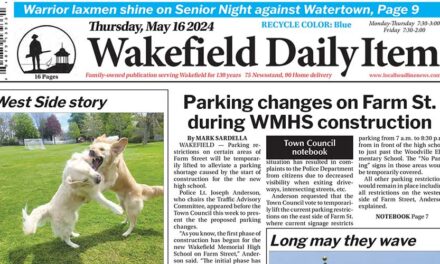By MARK SARDELLA
WAKEFIELD — Town Administrator Stephen P. Maio discussed with the Town Council last week Wakefield’s use of federal American Rescue Plan Act funds, reviewing spending to date as well as proposed uses for the money going forward.
The federal American Rescue Plan Act, commonly known as ARPA, provides funds directly from the US Treasury to the state and its municipalities from the Coronavirus State Fiscal Recovery Fund and Coronavirus Local Fiscal Recovery Fund. ARPA was signed into law on March 11, 2021 and must be used for expenses from March 3, 2021 forward. All spending must be incurred or obligated by December 31, 2024.
Wakefield’s share of ARPA funds comes to $8,083,935, Maio noted. He talked about the five categories of expenses that the funds can be used for:
1. Public health spending
2. Economic impacts of the public health emergency
3. Lost public sector revenue
4. Premium pay for essential workers
5. Water, sewer, and broadband infrastructure
Areas covered under “public health spending” include COVID-19 mitigation efforts, medical expenses, behavioral health, and health and safety personnel.
Under “Economic Impacts of the Public Health Emergency,” Maio explained, ARPA funds may be used to mitigate economic harm to workers, households, small businesses, nonprofits and education.
Under the category of “Lost Public Sector Revenue,” Maio noted that a town may accept a standard allowance of up to $10 million to spend on “government services.” But he stressed that the money cannot be spent to fund debt service or to replenish reserves. ARPA funds also cannot be used to settle judgements, provide tax reduction or for pension fund deposits.
Eligible costs covered under “Premium Pay for Essential Workers” include critical infrastructure personnel and overtime costs.
Under “Water, Sewer, and Broadband Infrastructure,” ARPA funds can be spent on clean water access, wastewater and stormwater, broadband access and cyber security.
Maio said that on Dec. 16, 2021 a webinar was held with about 20 attendees who discussed ways to use local ARPA funds. He said that based on their comments, the webinar participants wanted to see ARPA funds directed toward the following areas:
• Increased mental health services for students and residents
• Outdoor projects including green space, pedestrian access, and amenities
• Pop-up events
• Essential worker pay
• Business support including outdoor dining and façade improvements.
The town also did a public survey, Maio said, which drew participation from 57 respondents..
The survey results had 45 percent wanting funds spent on premium pay for essential workers. Another 18 percent favored spending ARPA funds on outdoor amenities (sidewalks and green space). Twelve percent wanted money used for providing masks and testing. Another 12 percent listed infrastructure needs as a priority. Eight percent wanted tax relief and 7 percent wanted mental health and wellness to be targeted for funding.
Maio talked about the ways that ARPA funding has been applied to the FY 2022 (current year) town budget. A total of $20,352 was used at Town Hall to pay the “greeters.” The police budget got $18,750 to increase the mental health clinician’s hours. The schools got $400,000. Another $7,658 went to supplement public health nursing services.
For the FY 2023 budget, Maio proposed using $21,500 to continue funding the Town Hall greeters. He proposed using $145,000 to expand the Health Department. Another $363,000 would go to the schools. For FY2024, Maio suggested that another $75,000 go toward health services, for a total budget-related ARPA spending total of $1,051,260 for the three years.
Maio talked about $434,141 in other ARPA expenditures including school and first responder overtime, contact tracing, test kits and clinics as well as COVID mitigation for elections and Town Meeting. Covering Fire Department overtime due to COVID-related absences was also mentioned.
Maio also discussed proposed expenditures for the remaining money.
He proposed putting $500,000 toward business/nonprofit grants, including restaurant patios and improvements to the built environment of neighborhoods (e.g., façade improvements, digital marketing).
He talked about spending $5.5 million on infrastructure, including Investments in parks, public plazas, and other outdoor recreation spaces, promoting healthier living environments and outdoor recreation and socialization along with enhanced sidewalk connectivity. He proposed $100,000 going to households and $506,192 to be set aside for unexpected future contingencies.
Town Councilors also weighed in on the ARPA spending. Councilor Mehreen Butt said that she didn’t want the funds used to supplant money already appropriated and committed to specific uses, but rather for it to be used for new and different things beyond what has been already funded through the town budget.
Councilor Ann Danehy noted that WCAT has stepped up during COVID to cover many more meetings than ever before even as their funding from cable franchise fees dwindled. She suggested that assisting WCAT “fits ARPA funding quite well.”
Town Councilor Edward Dombroski liked the idea of using funds to help liven up the downtown with things like “pop-up” events.
Councilor Jonathan Chines wanted the ARPA spending to be a monthly topic for discussion on the Town Council agenda to review specific ways to spend the $5.5 million for “infrastructure.”
Town Councilor Michael McLane advocated spending some ARPA funds of more senior housing and exploring the possibility of direct payments to essential workers.




